Rudy Rucker's Blog, page 36
June 27, 2013
Full Illustrations For THE BIG AHA
So, cool, the Kickstarter funding for The Big Aha is still going up. Yeah, baby! I’m casting off the shackles of the conventional pub biz.
I’ve formulated a new goal, which is to include an illustration for each of the book’s thirteen or fourteen chapters. This is the kind of thing I’d never be allowed to do with a commercial publisher. But I’ve looked at the production costs and my goal is entirely feasible.
My plan is that The Big Aha will include about fifteen of my paintings as illustrations, one per chapter, plus one on the cover.
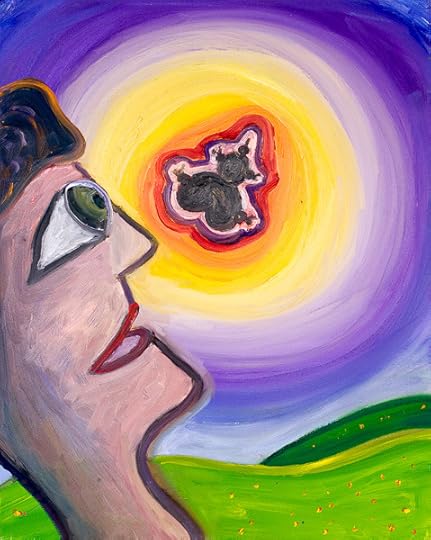
So now I’m planning for several new paintings. But—not to kill myself with overwork—I’m going to repurpose some of my older paintings as well. I might use the Big-Aha-vision-type painting above, for instance, which is titled He Sees The Fnoor. Is that a Mandelbrot set in the sky? Or…maybe it’s an alien gub!
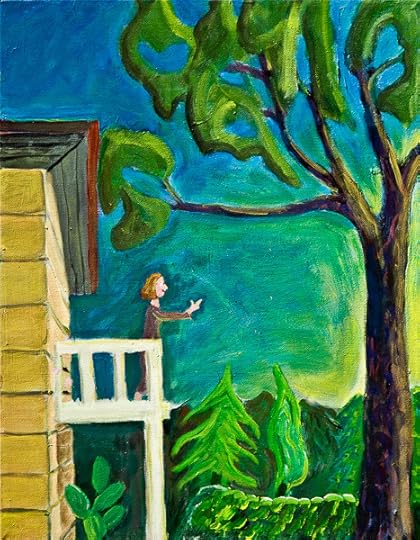
Here’s another type of Big-Aha-vision painting that I want to use. This one’s called Dawn. It’s a painting of my wife early in the morning on our back porch. It’s a Zen type of Big-Aha-vision painting—where the Great Enlightenment is right in front of you, if only you can learn to see it.
But don’t worry, I’ll have plenty of gnarly SF-style illos as well! Like the one I’m working on right now—this one’s called The Mr. Normals Versus The Myoor. I’ll let you have a look at it when it’s a little further along. This particular painting will be useful for me, as it’s a previsualization of what I’m going to write in the next chapter.
What’s a Mr. Normal like? Well, he’s a biotech robot akin to Gyro Gearloose’s assitant, Li’l Bulb. Has a lightbulb for his head. What’s a myoor? You’ll see.
June 23, 2013
Kickstarter Hits Target! “A Gub On Her Bed.”
My Kickstarter campaign to fund my next novel The Big Aha is coming along well—and many thanks to my backers. With any luck we may pass my targeted goal this week. [Update: We passed the target of $7,000 on June 25, 2013.]

Like a door opening up in the heavens! A glorious tunnel in the sky to Parnassus.
Last year I figured out the mechanics of making a novel into an ebook and a print book and getting it distributed online and even in few bookstores. It’s a more complex process than I realized at first—I put most of what I learned about making ebooks into a series of 4 blog posts, “How To Make Ebooks #1 – #4”. And with some trace of irony, I combined this material and cleaned it up a bit to make an ebook called How To Make An Ebook. And making a print book with InDesign is a whole other story, but I’ll blog about that at some later time.
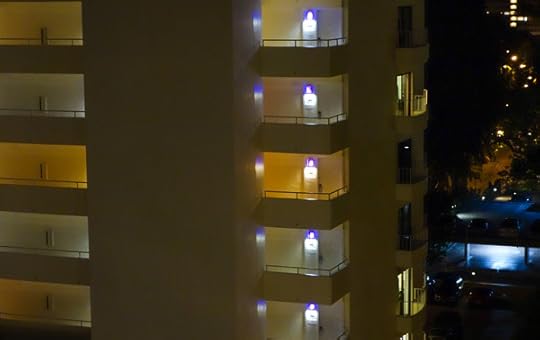
Anyway, the point that I want to make today is that, once you know how to make and distribute your own ebook and print books, one of the main things you’d still want to have a publisher for is to pay you an advance on the royalties for your expected sales.
But, with any luck, Kickstarter lets you sidestep this need. Given that all of my backers will get an ebook of THE BIG AHA (and in some cases an paper copy as well), I am in effect doing advance sales. So in some ways the process is very similar to getting an advance from a publisher.

My readers are in effect my publisher now—and they’re kindly paying me my advance. With no intermediaries. Even better, they’re offering me more than precise remunerations for the goods offered, they’re open-handedly and generously encouraging me to continue my work by paying extra. So there’s an element of getting a grant here too.
I was discussing some of these issues with the writer Tim Pratt last month and he used a word I like. Disintermediation. As in, “Electronic publication really calls for disintermeditation.” That is, selling your creations as directly as possible to your consumers. With fewer and fewer intermediaries.
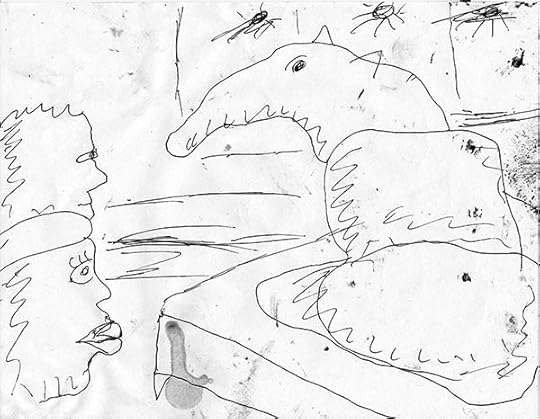
Sketch for “A Gub On Her Bed.”
Enough biz for the moment.
I have some creatures called gubs in The Big Aha . They appeared fairly early in my novel—I wrote about them in blog post called “Gubs and Raths” in November, 2012. At that point I just viewed as insignificant pests, on a level with dogs or pet pigs or rabbits.
But now, as I’m moving into the final chapters of my novel, I’m realizing that the gubs are incredibly powerful alien beings—very nearly at the level of gods. And I’m trying to get a clearer mental image of them.
So I made a nice lively sketch as shown above, kind of funny, at least to my eyes, messy, it only took a minute or two, and now I’m trying to translate that into an oil painting.
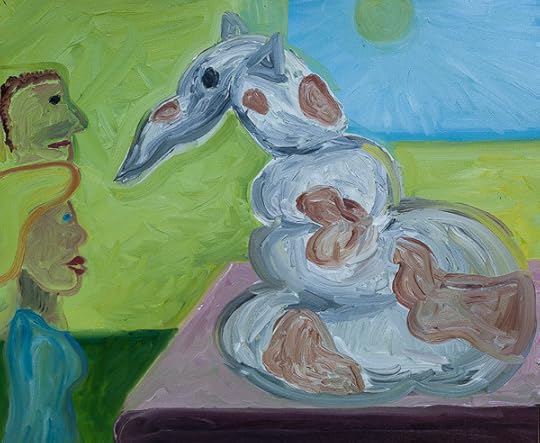
Draft #1 of Painting for “A Gub On Her Bed.”
What’s going on here is that a spotted gub is sitting on the bed in the apartment where my woman hero Jane lives. And Jane’s husband Zad is visiting, and they’re looking with some dismay at the fairly grubby gub on Jane’s bed. The spotted gub’s name is Duffie. They want him to leave.
This is only the first draft of the painting, and, yes, I know it doesn’t look that great yet. It’ll take maybe three more sessions to finish it. The gub looks funnier in the sketch with the slack neck and kind of looking over his shoulder; I want to put more texture into the wallpaper; give the gub some little paws; Zad and Jane should look livelier; there ought to be some object in the upper right corner like maybe a mobile or possibly a tiny distant gub seen through the window. A gubbess.
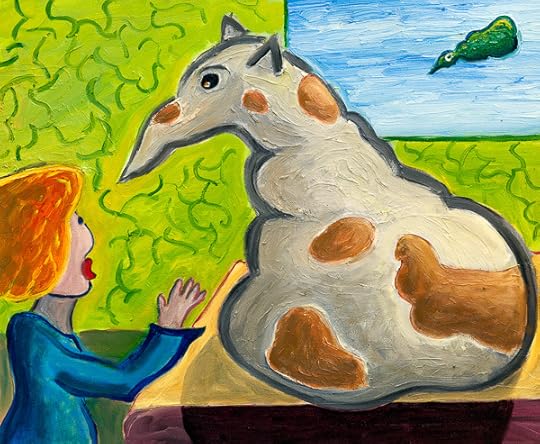
“A Gub On Her Bed,” oil on canvas, June, 2013, 24” x 20”. Click for a larger version of the image.
So okay, on June 25, 2013, I got the third, and final, version done. Having two people made too much clutter, so I cut it down to just the woman and the gub. And I put a girl gub out there in the sky, she’s green, her name is Sedusa.
I always like the idea of a painting that seems like an illustration of some unknown proverb or fable. At a metaphorical level, the gub might symbolize some kind of marriage problem.
By the way, you can get paintings of mine as rewards for the higher levels of pledging to my Kickstarter for The Big Aha . If I raise enough money, I plan to make a nice new edition of my art book, Better Worlds. And I want to do some more paintings relating to the novel.

One more shift of gears in today’s post.
An issue which one of my backers raised is the question of whether I would miss having an editor—which is one of the other things that a publisher provides.
With commercial publishing in the underfunded state that it is, an author often gets very little in the way of editorial comments anymore. My sense is that the editors are mostly focused on acquisition and on promotion, and they tend not to have much time for tweaking your book.
This said, on many books, I’ve gotten a few telling remarks that really did make a difference. But over the years, I’ve been getting less advice all the time. Possibly at this point, with the experience I have, I don’t need so much editing advice anymore—maybe having an editor is more important when you’re starting out. This said, I do know there’s a danger of an unedited author letting his or her work bloat and become fatuous.

A simple editing option for indies is to show a draft of the book manuscript to a few trusted personal friends whose judgment you trust, friends who are willing to take the time you read your manuscript. Pretty much any kind of comment can be useful. You don’t have to do everything your friends suggest, but if something confuses them or throws them off, then it’s often pretty easy to fix it. And if you feel too unsure of what you’ve done, you can hire a freelance literary editor, although here you may be getting into dangerous waters, that is, you might pay a lot for advice that’s not necessarily very useful.
Whatever! My big issue right now is to write a few more scenes about Zad, Jane and the gubs!
Kickstarter Going Good. “A Gub In The Bed.”
My Kickstarter campaign to fund my next novel The Big Aha is coming along well—and many thanks to my backers. With any luck we may reach my targeted goal this week.

Like a door opening up in the heavens! A glorious tunnel in the sky to Parnassus.
Last year I figured out the mechanics of making a novel into an ebook and a print book and getting it distributed online and even in few bookstores. It’s a more complex process than I realized at first—I put most of what I learned about making ebooks into a series of 4 blog posts, “How To Make Ebooks #1 – #4”. And with some trace of irony, I combined this material and cleaned it up a bit to make an ebook called How To Make An Ebook. And making a print book with InDesign is a whole other story, but I’ll blog about that at some later time.

Anyway, the point that I want to make today is that, once you know how to make and distribute your own ebook and print books, one of the main things you’d still want to have a publisher for is to pay you an advance on the royalties for your expected sales.
But, with any luck, Kickstarter lets you sidestep this need. Given that all of my backers will get an ebook of THE BIG AHA (and in some cases an paper copy as well), I am in effect doing advance sales. So in some ways the process is very similar to getting an advance from a publisher.

My readers are in effect my publisher now—and they’re kindly paying me my advance. With no intermediaries. Even better, they’re offering me more than precise remunerations for the goods offered, they’re open-handedly and generously encouraging me to continue my work by paying extra. So there’s an element of getting a grant here too.
I was discussing some of these issues with the writer Tim Pratt last month and he used a word I like. Disintermediation. As in, “Electronic publication really calls for disintermeditation.” That is, selling your creations as directly as possible to your consumers. With fewer and fewer intermediaries.

Sketch for “A Gub In The Bed.”
Enough biz for the moment.
I have some creatures called gubs in The Big Aha . They appeared fairly early in my novel—I wrote about them in blog post called “Gubs and Raths” in November, 2012. At that point I just viewed as insignificant pests, on a level with dogs or pet pigs or rabbits.
But now, as I’m moving into the final chapters of my novel, I’m realizing that the gubs are incredibly powerful alien beings—very nearly at the level of gods. And I’m trying to get a clearer mental image of them.
So I made a nice lively sketch as shown above, kind of funny, at least to my eyes, messy, it only took a minute or two, and now I’m trying to translate that into an oil painting.

Draft #1 of Painting for “A Gub In The Bed.”
What’s going on here is that a spotted gub is sitting on the bed in the apartment where my woman hero Jane lives. And Jane’s husband Zad is visiting, and they’re looking with some dismay at the fairly grubby gub on Jane’s bed. The spotted gub’s name is Duffie. They want him to leave.
This is only the first draft of the painting, and, yes, I know it doesn’t look that great yet. It’ll take maybe three more sessions to finish it. The gub looks funnier in the sketch with the slack neck and kind of looking over his shoulder; I want to put more texture into the wallpaper; give the gub some little paws; Zad and Jane should look livelier; there ought to be some object in the upper right corner like maybe a mobile or possibly a tiny distant gub seen through the window. A gubbess.

One more shift of gears in today’s post.
An issue which one of my backers raised is the question of whether I would miss having an editor—which is one of the other things that a publisher provides.
With commercial publishing in the underfunded state that it is, an author often gets very little in the way of editorial comments anymore. My sense is that the editors are mostly focused on acquisition and on promotion, and they tend not to have much time for tweaking your book.
This said, on many books, I’ve gotten a few telling remarks that really did make a difference. But over the years, I’ve been getting less advice all the time. Possibly at this point, with the experience I have, I don’t need so much editing advice anymore—maybe having an editor is more important when you’re starting out. This said, I do know there’s a danger of an unedited author letting his or her work bloat and become fatuous.

A simple editing option for indies is to show a draft of the book manuscript to a few trusted personal friends whose judgment you trust, friends who are willing to take the time you read your manuscript. Pretty much any kind of comment can be useful. You don’t have to do everything your friends suggest, but if something confuses them or throws them off, then it’s often pretty easy to fix it. And if you feel too unsure of what you’ve done, you can hire a freelance literary editor, although here you may be getting into dangerous waters, that is, you might pay a lot for advice that’s not necessarily very useful.
Whatever! My big issue right now is to write a few more scenes about Zad, Jane and the gubs!
June 20, 2013
Kickstarter For THE BIG AHA
The big news today is that I’ve launched a Kickstarter project to fund the publication of The Big Aha, the novel I’ve been working on for roughly a year. I’m already getting a good response—and thank you for that, dear backers—so I’m optimistic that the project will be funded. Thanks also to Mark Frauenfelder for mentioning the project on BoingBoing, which is a huge help.

I plan to publish The Big Aha with my own Transreal Books. I’ll probably use one of my paintings on the cover, maybe the one above, which I call The Lovers, and which depicts the notion of telepathy. I’m still doing some more paintings relating to the book, so it’s not certain I’ll use this one.
Now, I probably could have placed The Big Aha with a commercial publisher—but that’s been getting harder over the last few years, with longer waits, more anxiety, less promotion, less actual editing, less proofreading and smaller advances. Less fun. We’re in a phase shift time, a transition from one era to another. From thuddy dinosaurs to nibbling mammals, maybe.

Going totally indie like this, I feel like I’m escaping into a promised land. Doing the Kickstarter move gives me renewed enthusiasm about making a final push to finish The Big Aha. I’ve been working on it off and on for over a year. I wrote the first two chapters early in 2012, and then spent seven months learning how to self-publish, then I got back into The Big Aha in the fall of 2012. And now I’m pretty near the end. I’ve been really pushing on the book all spring, and it’s been a little draining.
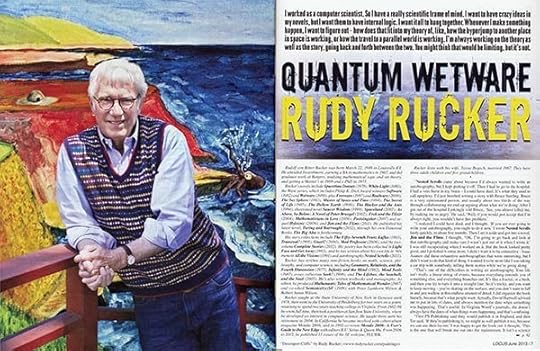
Something else I want to mention today is that I had a big interview in this month’s issue of Locus, the magazine of the SF & fantasy field. I’ve reprinted the story’s lead pages above, and you can read some excerpts free online. As it happens, some of the things I talked about in the interview were The Big Aha , self-publishing, and the option of using Kickstarter to raise funds for a book launch.
The interview is by Liza Groen Trombi, who also took the photo of me. Francesca Myman designed the illo, putting one of my paintings in the background. Thanks, guys! And thanks to the younger writer Tim Pratt, also of Locus, who gave me some much-needed encouragement about attempting a Kickstarter.

“Ant and UFO,” oil on canvas, May, 2013, 20” x 16”. Click for a larger version of the image.
One last thing. Near the end of May, I took a couple of days off from the writing and did a quick little painting Ant and UFO—the usual suspects. To start with, I searched the web for good images of ants and I found a nice clear drawing in an exterminator’s ad. After I’d painted the ant, I wasn’t sure at first about what else to put in, and then I had the idea of having a tiny UFO—I love paintings UFOs, they’re easy to paint, and they carry a lot of symbolic weight. The ant’s body was at an odd angle, and I had the idea of having her standing on three blades of grass, which made for a nice composition.
The last few weeks I’ve been planning the final chapters of The Big Aha, and gearing up for the Kickstarter launch. Feeling like a chicken with his head cut off, a little bit. Maybe I’ll take a break and do another painting today. I’ve got these meddling semi-divine beings called “gubs” in The Big Aha, and I’d like to paint one of them who’s sitting on a bed in the apartment of my characters Zad and Jane’s apartment, and they kind of wish he’d leave, as he’s a fairly grungy gub, a little like a dappled Gloucestershire pig with a pointed anteater nose.
May 27, 2013
The Lick Observatory on Mount Hamilton
I mentioned that I went to watch the Science Fiction Writer’s of America Nebula Awards meeting in downtown San Jose last week. Right next door in the San Jose convention center was a comics convention, with a hundred times as many people attending.
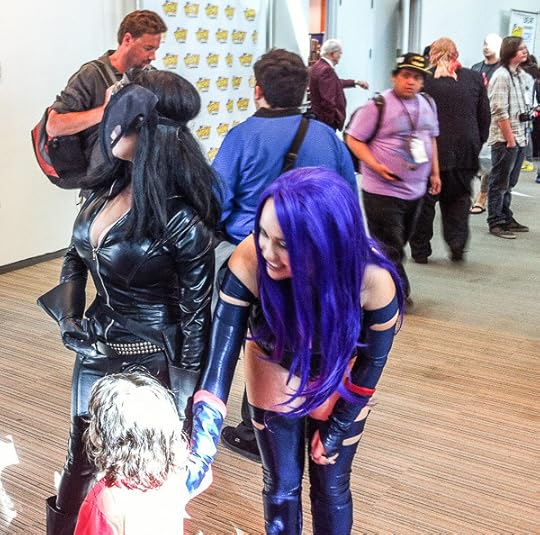
These women had dressed up and were hanging out outside the paying entrance to the con so people could talk to them and take their pictures. Being stars. A vintage comix con scene.

Another guy was dressed up like a bull called Bull-It. Also vintage. Often we have people like this mixed in with the writers and editors at SF cons, but this time we were at separate meetings.
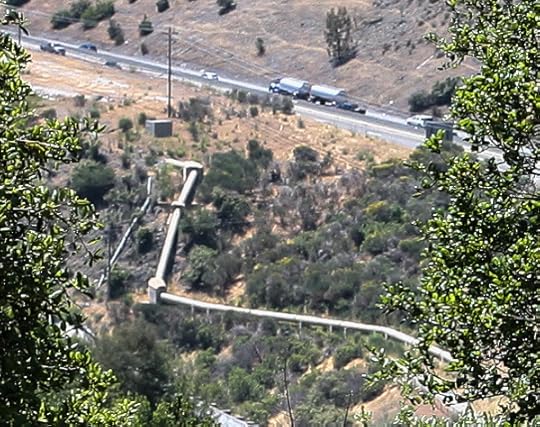
I’ve been out hiking pretty often around my neighborhood lately, beating cross-country through brush up towards St. Joseph’s hill above Los Gatos. I’m using my new wide-angle lens a lot. It takes very sharp images, so I can crop down to, like, tiny postage stamp area out of a picture to get surveillance-style photo like this. Afghanistan on Route 17!

When I get to the top of the hill, and it’s a steep, long climb, I lie down under this one particular tree and mark up my latest print-out of plans or text from my nearly finished novel The Big Aha. I call this my “field office.” I’m so exhausted by the time I get up here that the ground feels incredibly comfortable, and my mind is empty, and I’m happy.
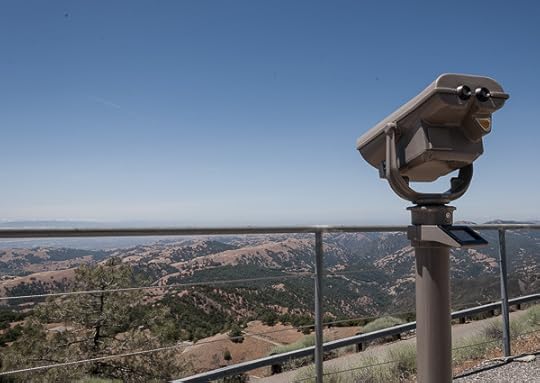
Another surveillance image, this one is a pair of free binoculars near the observatory up at the Lick Observatory on Mt. Hamilton near San Jose.
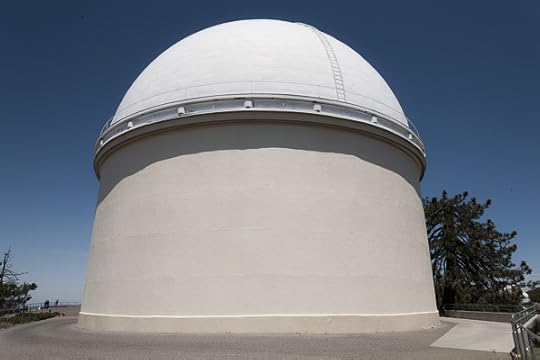
The first part of the Lick Observatory was finished in 1888. This building has an old-school refractor (with lenses) telescope installed. This guy James Lick paid for it, he’d wanted to have a pyramid larger than the Pyramid of Giza erected in his memory on a full city block in San Francisco, but the city fathers nixed it.
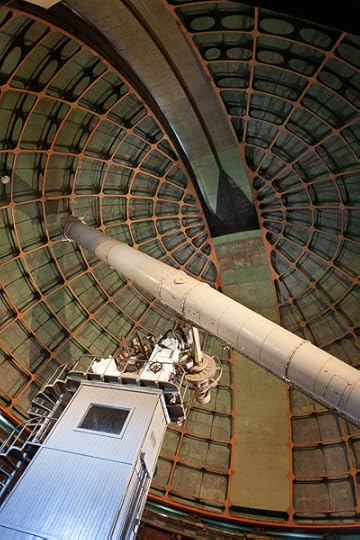
The over-a-century-old scope is kind of beautiful against the ribbing of the dome. The scientists don’t actually use it anymore, they have a more modern reflecting telescope up there they use instead.

We went up there the Sunday of Memorial Day weekend—our concept was not to do the obvious thing and to drive to the beach in Santa Cruz—this way we didn’t have any traffic probs. But there were a zillion bicyclists riding up the 4,000 fee to the observatory. People are so intense about exercise anymore, I wonder why that is.
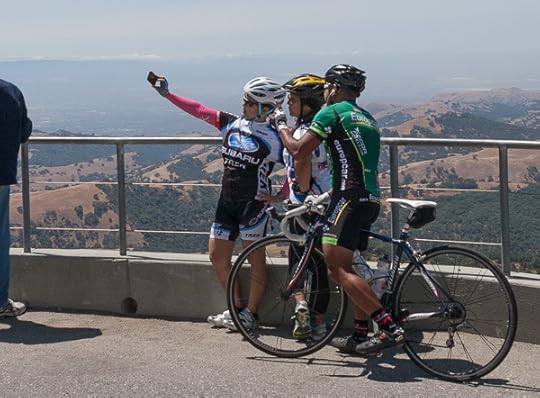
In any case, they were having fun. And then they got to do an insanely long coast downhill.

There’s a bunch of other domes for ‘scopes up on Mt. Hamilton. Pushing up like puffball mushrooms.

The big reflector ‘scope is in this vaguely Art Deco building, nobody around in the daytime, with the ‘scope behind a glass wall. I like the single word PULL here.
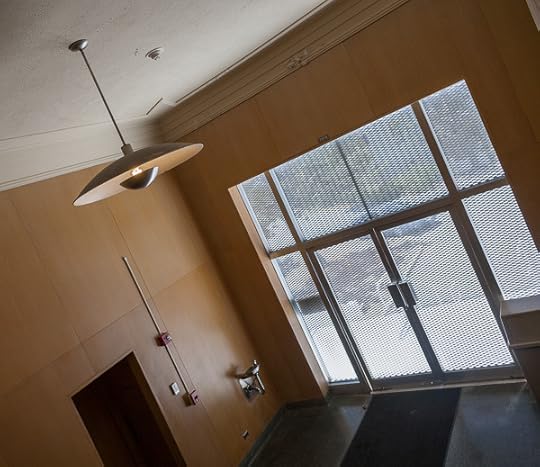
Click for a larger version of “The Theory of Everything.”
Inside the building I got a wide-angle picture in the entrance hall that I really like. I call this “The Theory of Everything,” my idea being that we have all of these very precisely located and well-describable object arranged just so in this clear-cut space, and there’s a curious domain wall beyond which is the bright-matter zone called outdoors, with a car particle visible. But here inside the dim ocher room, our system works. You can even see a water fountain particle, as predicted by our theory.

The had this one cute little dome, the Automated Planet Finder, and it looked like Sonic the Hedgehog with a Mohawk.

Later we parked halfway down Mt. Hamilton and walked a bit along a trail off the “Two Gates” point in Grant Park, and I saw this amazing Oriental-tapestry-type oak tree. Having left my superduper theory-of-everything 5D camera in the car, I took a lo-res surveillance photo with my smart phone that sort of captures the idea, after I tweaked it like a mofo in Lighroom. But I still want to go back there and really nail the image for my as-yet-incomplete report on this zone of the Milky Way Galaxy.
May 20, 2013
Golden Gate Bridge, Futurism, & the SF Biz
My wife and I were up at the Marin headlands and at the Cavallo Point Lodge in the Fort Baker Park this week.

It was a conference sponsored by the Institute for the Future (IFTF), and organized by David Pescovitz. A lot of corporations and agencies sent people to join in discussions with futurists of IFTF about the coming age of “Networked Matter.” Pescovitz had the great idea of getting six SF writer to write stories about this theme, and he bound them into a little book. The stories will, I believe, appear on the BoingBoing web site as well, and at that point I’ll link to my story, called “Apricot Lane.”

I’d never known this little park exists, it’s off Alexander Road, just north of the Golden Gate Bridge. I had fun walking around taking photos.
The tack I took in my story is that it wouldn’t be good for us if all objects were in some way linked to the web, endowed with a bit of AI, and able to communicate. As I put it in my story, “Everything in the world was on the make. Everything was potentially a bully, a snitch, a shopkeeper, a do-gooder, a scammer, a marketeer, an enemy, a beggar, a bore, a landlord.”
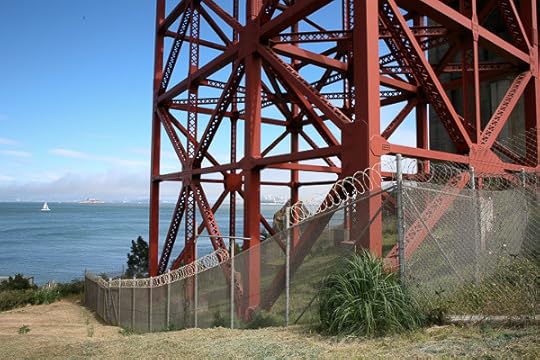
The Golden Gate Bridge itself is a networked object now. It looks at your license plate and debits your account for the cost of a toll. In my story I was imagining that even sidewalks might start doing this. Exacting a micropayment for each step on the civic concrete. If you’re broke, you walk on the dirt at the edges. Otherwise some freelance social workers might come after you to earn some payments for themselves.

Mark Frauenfelder of BoingBoing was at the networked matter conference for a bit, I had lunch with him, it was good to reconnect. He was in town for the Maker Faire. I actually used to have a column in BoingBoing when it was a print zine, like 25 years ago.

After the networked matter do, I went to Science Fiction Writers of America (SFWA) Nebula awards in San Jose, kind of a random whim. I haven’t been a dues-paying member of SFWA for many years, but the event was handily nearby. I did the dinner and awards and all; I went mainly for the schmoozing. Saw some old friends—Terry Bisson, Stan Robinson, Dave Hartwell, Karen Joy Fowler, Sheila Williams, Greg Benford. Didn’t manage to talk to many younger writers.

After 20 or so novels and some 70 published stories, I’ve never even been nominated for a Nebula, so attending the awards event wasn’t the best thing for my mental serenity.
In any case, Bob Silverberg did a very nice job of hosting, with many jokes and jabs. It felt vaguely like the Golden Globes awards, with the audience around dinner tables. And, when Gene Wolfe was given the SFWA Grandmaster award he give a very touching acceptance speech, about his perennial worries about being liked or admired as a writer, and how he opens up his old books now and then, and thinks peacefully to himself, “Yes, this … this is a good book.” And at his level, he’s bummed that he never got a Hugo. There’s always a next floor.

Sitting at the banquet, I realized it’s very likely I never will get the SFWA Grandmaster award myself, but it really doesn’t matter, get that through your head, Rudy, be happy for the things you have.
Good things: I’m almost done writing The Big Aha. And I’ll have a cover story interview in the June issue of Locus , the magazine of the SF and fantasy field.

The writing’s been really enjoyable lately. Writing a novel means facing blank canvas every day, for hundreds of days, every day it’s impossible, but somehow you do it.
And in some sense, the novel is writing you. The world, or the muse, or the muse-in-the-world dances with you to the rhythms of the work. And you have something fun to think about, a mental world to visit.
And then you’re done, and out of Eden, and trying to peddle the thing once again, and it’s just a stack of paper, a slew of bytes. And I’m now segueing into that stage. Less enjoyable than writing! But interesting in it’s own way.
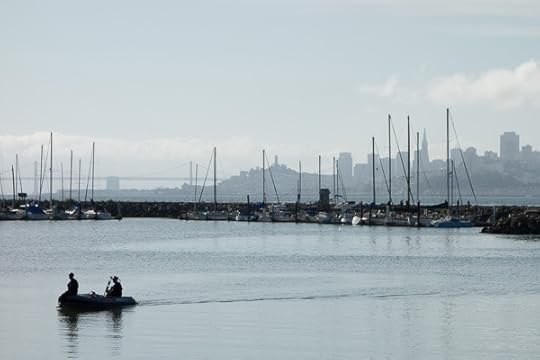
If all else fails, there’s always the self-publishing option, which I took with my last novel, Turing & Burroughs.
A new wrinkle on self-pub or small-press-pub is that you can try to raise something like a book advance via Kickstarter. I’ve been intrigued by the recent successful Kickstarters launched by the talented young writer Tim Pratt, like this one he did for a Marla Mason novel.

It’s a strange new landscape in publishing. The Berlin Wall is falling down…
May 7, 2013
Photo Clearance
More photo clearance today with whatever comments come into my head.
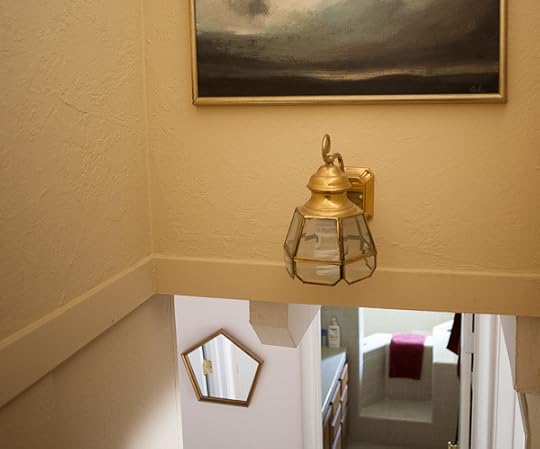
I like how the wideangle lens has so much depth of field. That five-sided mirror has always caught my fancy. Almost like something you’d see in a ghost story. There was a time in high-school when I’d seen too many scary episodes of “Outer Limits” that I was scared of things coming out of mirrors. And of disembodied hands.

This is out past Four Mile beach north of Santa Cruz. Wide open. You walk a ways along this cliff and you see a lot of seals.

A very deserted spot, this cliff north of Four Mile. As soon as the seals heard me taking a picture, a lot of them began humping into the water. Love the babies, the size of dachshunds.
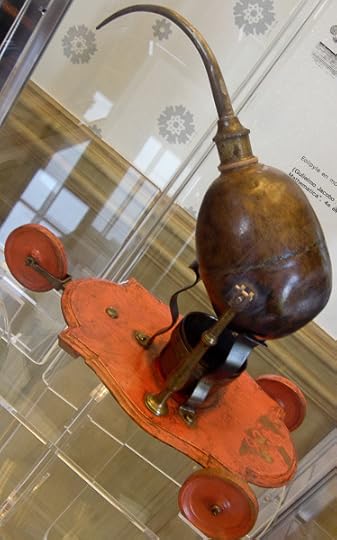
This one is quite an old photo, of a table-top steam engine, built for fun or for teaching, spotted in the wonderful and quaint Museum of the History of Scientific Instruments in the Perle Du Lac park by Lake Geneva in Switzerland.
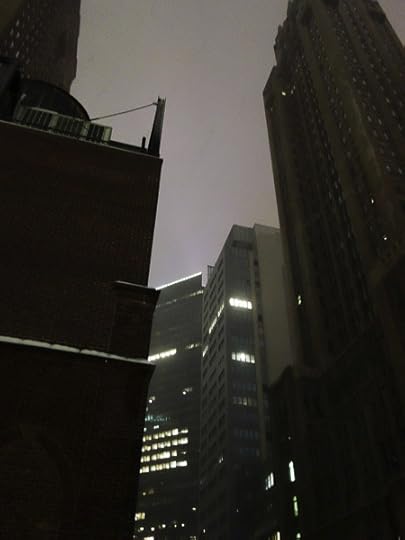
In old Manhattoes in a snowstorm, and the buildings looming.
(This name for Manhattan was in fashion in the late 1880s, see Herman Melville, in Moby Dick: “There now is your insular city of the Manhattoes, belted round by wharves as Indian isles by coral reefs — commerce surrounds it with her surf.”)
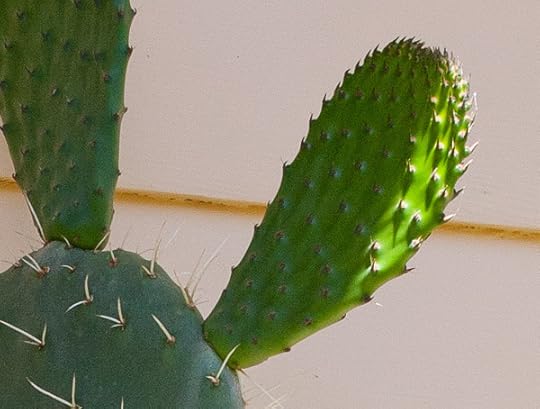
The prickly pear in our backyard cactus garden. I actually brought in a single pad of this cactus after a visit to Maui about eighteen years ago. The pad’s been very slowly growing out new pads, but recently I moved the plant out of a pot and into the garden it’s been going wild. Love that tasty green color in the small pad.

I don’t know if I mentioned that my autobiography, Nested Scrolls, is out in paperback as well as hardback and ebook now. I could use a few more comments on the Amazon page for the book, so if you liked it and have a spare moment…
Just recently I came across a great review of the book by Rob Latham in the LA Review of Books.

Some of son Rudy’s welded college-days artwork on the back porch. These pieces are old friends by now.
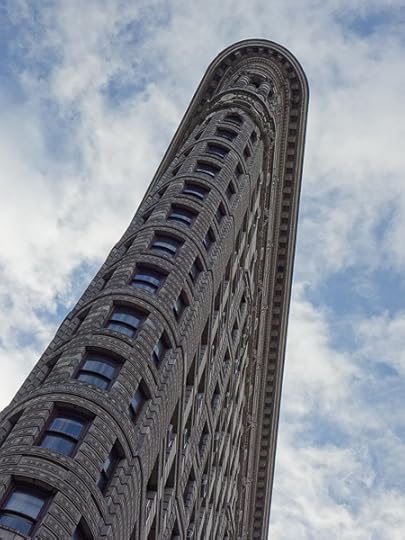
You can’t go wrong photographing the Flatiron Building in old Manhattoes. One of my irregular pilgrimages to the offices of Tor Books.
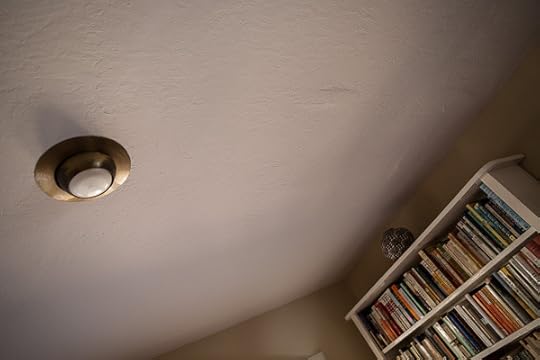
In certain moods, almost anything I look at seems worth photographing. Especially when I’m playing with a new lens!
May 5, 2013
Gnarl All Around
I’ve accumulated a backlog of photos to blog, but I don’t have any long essay-type thoughts today. All my energy is going into The Big Aha, which is about 80% done. I’m pushing pretty hard on it. During the closing phase of a finishing the first draft of a novel, I sometimes think of a predator who’s wounded his or her prey, and is now crashing through the underbrush, frantic to finish the hunt. Blood-lust writing frenzy.
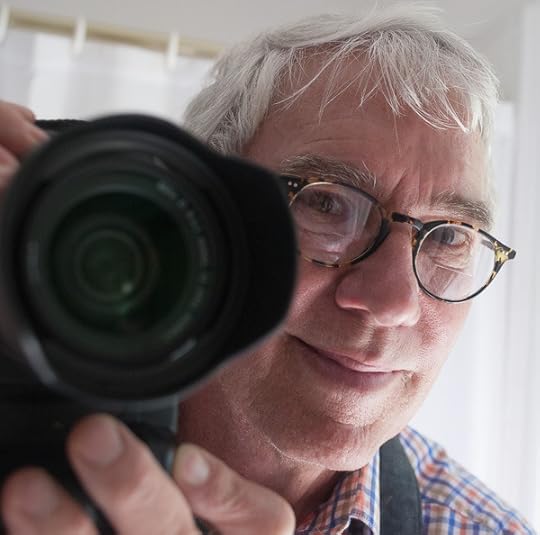
I got a new wide-angle lens the other day, a Canon 24 mm. I’d been making do with an old Leica lens on my Canon body, but the old lens didn’t have autofocus, nor image stabilization, nor did the automatic metering work with it. I will say that the Leica glass has a certain creamy warm quality that I like. But the Canon lens in incredibly sharp.
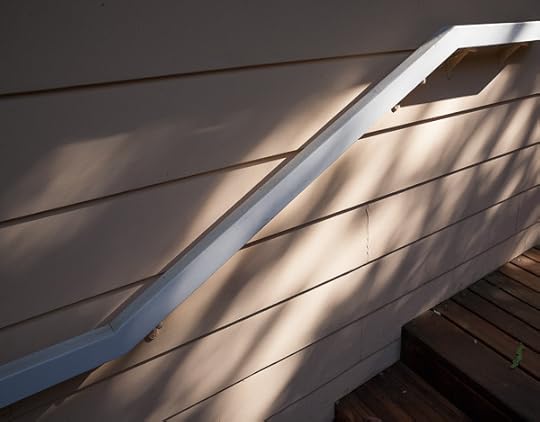
So I walk around my house photographing pieces of it. Like this banister. Not that every photo I’m running today is shot with the wideangle lens.

My usual morning regimen, is to do yoga on a mat in the back yard and correct a printout. At full resolution, this text is readable, thanks the new lens’s image stabilization, but maybe not readable in this shrunken rez. Lying in the back yard on a nice morning while crafting some prose is about my favorite activity.
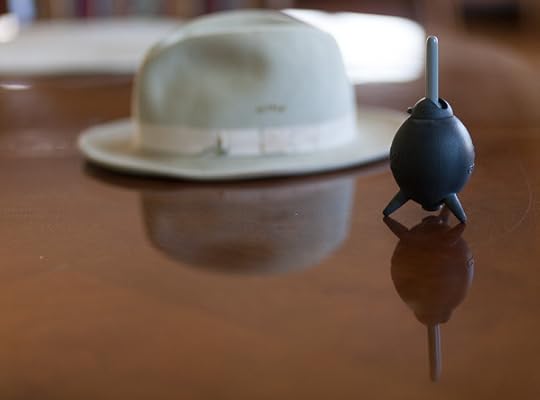
This photo’s taken with the Leica lens, and it has the creamy texture. Every hat is a UFO.
I’m writing all day, and in the evenings I like to get away from the printed word, so we’ve been watching more Netflix than usual, a mixture of streaming and DVD. Finished off the second season of The Hour, a nice BBC show, although I have to turn on subtitles for shows like this, otherwise I miss about 30% of the dialogue. The Lillyhammer series isn’t bad either.

Switched over to a 100 mm zoom lens for this photo last night. As spring rolls on, there’s different cadres of bugs that turn up, all of them hatching at the same time. These guys were on the globes of our street lamp, making me think of astronauts on a moon.

The 100 mm lens is, for reasons I don’t quite understand, categorized as a “macro” lens, meaning you can do super close-ups. Hard to go wrong when you’re shooting a rosebud, although the depth of field is only a few millimeters deep and I have to click at the right moment to catch the image I want, given that my body is never quite still. Love the “bokeh” here, that is, the out-of-focus quality of the background.

The sun comes up really bright these days, blasting flat across Silicon Valley into my garage and bounces great caustic curve light splashes off my car. I looked up how bright the sun is, viewed as a lightbulb, and it’s said to be about 300 or 400 septillion watts. The prefix for septillion is “yotta,” in the same sense that “tera” means trillion. There’s an official committee that decides these things. So the sun is a 300 yottawatt bulb. Or, as a waggish friend commented, one might shop for a energy-saver 60 yottawatt sun.

I try to get out into the hills every couple of days, I never get enough of nature. Free gnarl. I think this is a eucalyptus trunk, they grow with a spiral grain, which makes them stronger I think. Last night it was really windy here, and the eucs were waving like seaweed. Always nice to be reminded that we live at the bottom of an ocean of air.

Sometimes I go hiking with my neighbor Gunnar. He’s originally from Norway and still has quite an accent—you have to know him for awhile in order to easily understand what he’s saying. He’s close to eighty, and is livelier and fitter than me. He never goes to what I could call “a real doctor,” preferring various kinds of Indian or Chinese healers. Seems to be working for him.

Gunnar and I were down at the foot of a waterfall in Castle Rock park, which is only about s twenty minute drive from my house. Incredible that I only go there once every year or two. It’s such a great place. What do I have to do that’s more important than being in the woods?

Oh, yeah, I have to be at home running my machines.
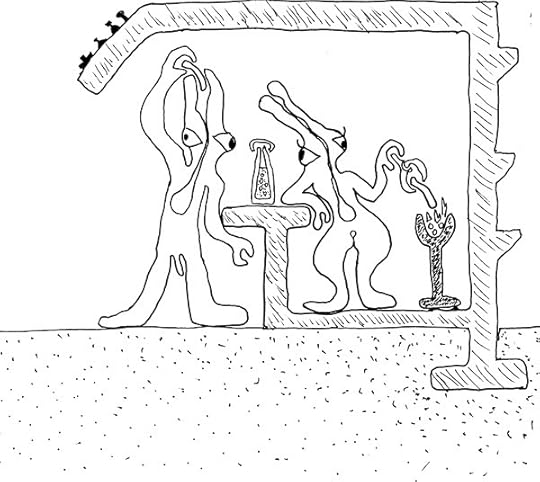
Converting my gauzy N-dimensional dreams into 2D art.
April 25, 2013
On the Road, Satori, and The Big Aha
I feel like I’m the only person I know who saw the movie version of Kerouac’s On the Road recently. I liked it a lot, I saw it twice—the first time on it’s release date, which was also my 67th birthday.
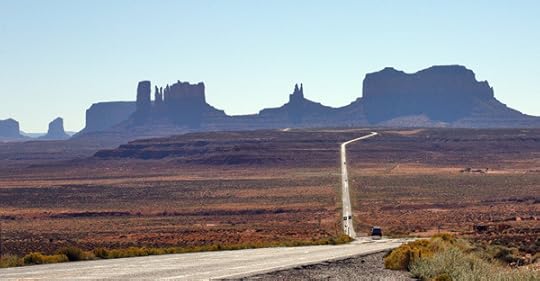
[Photo I took on one of our own Wild West road trips, first posted 2010.]
The movie didn’t get much publicity, and it wasn’t in the theaters very long. Hard as it is for this old geezer to believe, most people in the younger movie-going generation haven’t even heard of On the Road, and they have only a hazy notion, if any notion at all, of who Jack Kerouac was. Father Time plows us under.
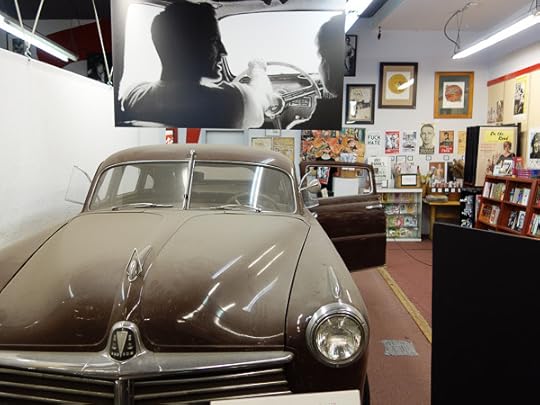
The movie includes a lovely 1949 Hudson car that Jack Kerouac, Neal Cassady, Luanne Henderson and Ed Dunkel drive from NYC to Algiers, Louisiana to visit William Burroughs, and then on to San Francisco.
As it happens, this very car, the one used in the film, is on display in the Beat Museum in San Francisco, just across Columbus Ave from City Lights Books. You can see the car for free, and if you pay a couple of bucks you can go in and see such Shroud-of-Turin level relics as Jack’s plaid coat.

Thinking about On the Road, I happened to recall a great passage in Chapter 11 where Jack describes him and Neal spending a night sleeping in an all-night movie theater in Detroit. I found the book online as one giant webpage, and searched that to find the key word “osmotic.”
For thirty-five cents each we went into the beat-up old movie and sat down in the balcony till morning, when we were shooed downstairs. The people who were in that all-night movie were the end. Beat Negroes who’d come up from Alabama to work in car factories on a rumor; old white bums; young longhaired hipsters who’d reached the end of the road and were drinking wine; whores, ordinary couples, and housewives with nothing to do, nowhere to go, nobody to believe in. If you sifted all Detroit in a wire basket the beater solid core of dregs couldn’t be better gathered. The picture was Singing Cowboy Eddie Dean and his gallant white horse Bloop, that was number one; number two double-feature film was George Raft, Sidney Greenstreet, and Peter Lorre in a picture about Istanbul. We saw both of these things six times each during the night. We saw them waking, we heard them sleeping, we sensed them dreaming, we were permeated completely with the strange Gray Myth of the West and the weird dark Myth of the East when morning came. All my actions since then have been dictated automatically to my subconscious by this horrible osmotic experience.
Love that last sentence.

Onward. These days, as I’ve been mentioning, I’m working on a novel called The Big Aha, and I’m nearing the end. And I want to come up with an explanation of what I mean by the psychic state that I call “the Big Aha.”
What I term the “cosmic mode” in the novel is an intuitive, immediate knowledge of the world — what we might call a mystical grasping of the world in its unity. A characteristic feature of cosmic-mode knowledge is that it avoids distinguishing between the knower and the known, the subject and object. You see the world as One.
In what I call the ”robotic mode”, we have a discursive, analytical knowledge of the world — rational thought. In the robotic mode you stand apart from the thing known. You see the world as Many.

The point is not that mystical, all-is-One, cosmic-mode knowledge is preferable. Both the cosmic and robotic modes of knowledge are real, and both are important. But it is very hard — perhaps impossible — for us to see the world in both ways at once. At any instant we see the world either as One or as Many.
Moving from Many to One tends to be a gradual process, the result of some kind of deliberate calming of the mind. But the passage from One to Many is usually sudden. At a given instant you may be sunk into a complete unity with the world. And then an instant later you are talking about your experience, standing outside yourself, making distinctions. The difficult thing is to catch the instant when you are still between One and Many. I sometimes think of this instant as the slash mark in the One/Many problem, that is the problem of how the world can be both One and Many at once.
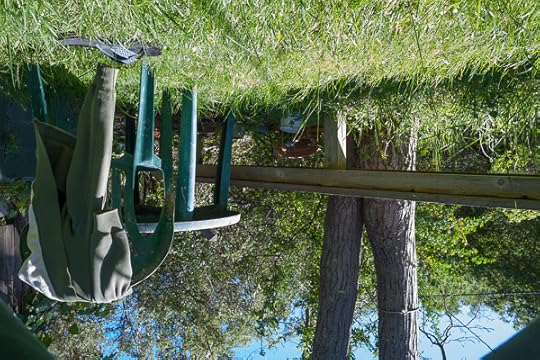
[World seen through my legs while doing yoga.]
In his essay, “The Meaning of Satori,” which appears in his book The Field of Zen, the author D. T. Suzuki says this instant is the fleeting enlightenment that Zen calls satori. “The oneness dividing itself into subject/object and yet retaining its oneness at the very moment that there is the awakening of a consciousness — this is satori.”
This sort of satori is fleeting, but not rare. One could almost say that the natural rhythm of thought is an oscillation between One and Many. As you look around the room there are constant microlapses of attention. You reach out and merge with the world, then draw back and analyze. At one instant there is only is-ness, at the next there is a person cataloging his perceptions. One-Many-One-Many … at a rate of, say, three cycles per second.

Here’s a picture of this taken from my nonfiction book Infinity and the Mind, my bestselling book ever. It represents the mind of indicating a person who repeatedly sinks down into blissful union with the One, only, each time, to snap back to ordinary rational consciousness. The points labeled “S” might be the satori points.
There is a sense in which waking up each morning is a satori. On a good day (no alarms, no clock to punch) you float up from sleep into an idle state of is-ness, not even thinking who or where you are. But this is too good to last . . . whisk clickety-click, and you’re planning your day Is it possible to notice the moment of switch-over?

When I was doing my research for book Infinity and the Mind, I came across a guy called Benjamin Paul Blood who was, one might say, one of the first-ever drug-mystic’s in the United States. He would equip himself with a handkerchief soaked in ether, hold it to his face, sink into unconsciousness, and then, as his nerveless hand fell away, he would wake back up. The experience of moving abruptly from artificial trance to normal awareness struck him as central, and he wrote something very interesting about it in an 1874 pamphlet, The Anaesthetic Revelation and the Gist of Philosophy. In the long quote below, I added three little clause numbers to make it easier to follow what he’s saying:
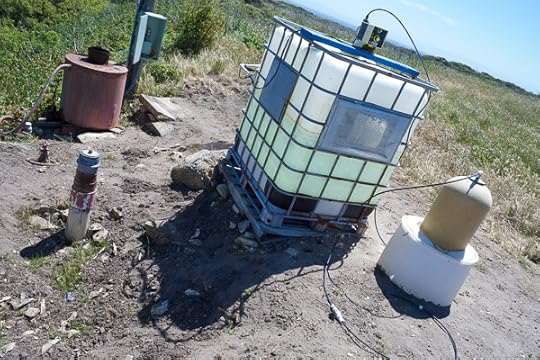
I think most persons who shall have tested it will accept this as the central point of the illumination: [i] that sanity is not the basic quality of intelligence, but is a mere condition which is variable, and like the humming of a wheel, goes up or down the musical gamut according to a physical activity; [ii] and that only in sanity is formal or contrasting thought, while the naked life is realized only outside of sanity altogether; [iii] and it is the instant contrast of this tasteless water of souls with formal thought as we “come to” that leaves in the patient an astonishment that the awful mystery of Life is at last but a homely and a common thing, and that aside from mere formality the majestic and the absurd are of equal dignity.
Satori, man.

Up until now I have been describing the interface between One and Many as something that one moves back and forth through in time. This is a bit misleading. In Suzuki’s words, “Satori is no particular experience like other experiences of our daily life. Particular experiences are experiences of particular events while the satori experience is the one that runs through all experiences.”
In other words, the One and the Many run about together in and out of every word ever uttered. The world is One and the world is Many. The One/Many split is the heartbeat of the universe, the charged tension that makes things happen.
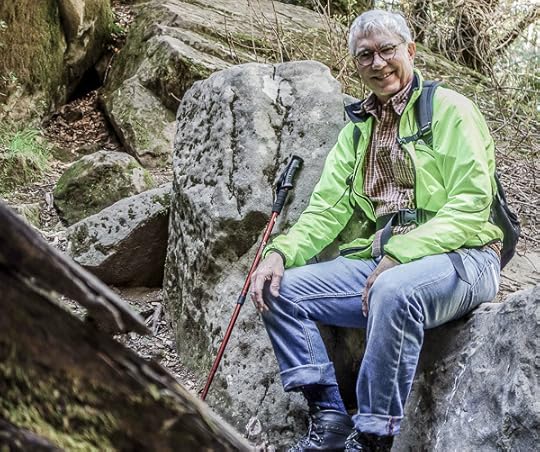
What happens in my novel The Big Aha is that my characters find a way to “jam open” the switch between the cosmic and the robotic mode, and they stay in cosmic mode for long periods of time, being One with reality, but without losing their ability to function.
And that’s the Big Aha experience that my book’s title is referring to. The Big Aha is that you can remain in cosmic mode and not be flipping out about it.
In writing my novel, I’d had some faint hope of finding a “higher” Big Aha in an alternate world that my characters visit. But I ended up with more of a D. T. Suzuki or Benjamin Paul Blood routine. Although your knowledge of the Big Aha may be sparked by some a unique and a trippy White Light experience, it ends up being being a part of daily life. You recognize the fact that you’re in the cosmic “All is One” mode a lot of the time.
This is all there is. What was I so excited about? What else did I expect?
Coming at this form of the Big Aha from another angle, think of what the great science writer Martin Gardner calls the “superultimate why question” in his essay, “Science and the Unknowable.” You start with, “Why does anything exist?” And, given any answer to that, you can say, “But where did that come from?” So you might as well short-circuit the process. There is no explanation beyond what we’re experiencing here and now.
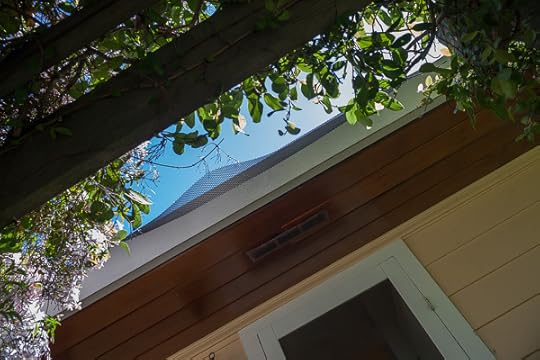
So….the Big Aha is? Be here now. Mindful. In the now moment.
You figure out the secret of life—fine. But you still have to go ahead and lead the whole rest of your life. Living in the Big Aha.
April 5, 2013
Leviathan Eats Us Via 4D Einstein-Rosen Bridges!
I had a big SF revelation this week, a breakthrough for my story. Today’s post will include some illustratiave drawings, also some semi-relevant or irrelevant (but nice-looking) photos.
I’m still working on my novel, The Big Aha. I’m about 75% done. Ever since the early chapters, I’ve had these two mysterious glass balls hanging around: the oddball and the dollshead. I wasn’t quite sure what they were going to do for me, but I had a sense that thought ought to be Einstein-Rosen (or “ER”) bridges to a parallel world that I call Fairyland. See my recent post “Four-Dimesional Portals to Other Worlds” for the story on ER bridges.
In the morning I wrote a scene at the start of where something like an elephant is pulled into the dollshead and it disappears. The mental image made me laugh: the fat elephant with trunk outstretched, thick legs star-fished out, thin tail trailing. Passing into and through the little Xmas-tree ball. While the elephant is going through, the ball swells up like a wobbly giant soap bubble, then shrinks back.

Then I went for a lovely and revivifying hike up over St. Joseph’s Hill above our house, the meadows green, the trees bosky, the sky adrift with plump sharp clouds. Lying there, fully at ease, I was wondering how some creature could contain an ER bridge and yet be an animal or monster with a body and a skin and so on. How would that work? I mean, an ER bridge is a wormhole connecting two spaces. How do you wrap a body around that?

I’ve been coughing for six weeks, and I’ve been thinking I might have pneumonia. I took a little nap on some soft long green grass and when I awoke, I felt like I was finally well. And, as an additional gift, I now had an aha moment. I had a vision of a largish creature, maybe as big as a whale, or maybe even bigger. Call him a leviathan. He lives in the parallel world. And the creature has a number of ER bridges within his body. They’re like vacuoles in the body of a paramecium.
I scrawled the two preliminary images below on a manuscript page I’d brought along on my outing. And the next day I drew something more elaborate. I’ll show those later in this post, but first here’s the crude ones.
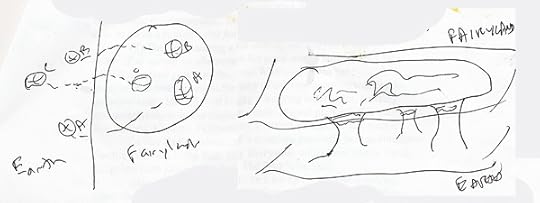
In order to discuss the situation further, I’ll use special names for two worlds. I’ve been calling them the Universe and Fairyland, but now I’d like to employ a more neutral usage that I coined in Postsingular and Hylozoic: Lobrane and Hibrane. We live in Lobrane, and Hibrane is the parallel world.
The two ends of an ER bridge between two 3D branes or worlds will appear to us like spheres. So, as I’m saying, the Hibrane ends of a group of ER bridges could very well be spherical vacuoles within the leviathan’s body, and these vacuoles connect to oddball-like spheres down here in our Lobrane.

I arrived at this image by thinking of a Flatland model. In the Flatland version we have the two planes with one or more ER wormhole throats connecting them. We draw a big dark glob on the upper plane. The leviathan. And the ER throats are within his body. And—crucial point—his dark flesh extends about 30% or even 90% of the way down each of the throats, holding those throats bulged out. But the flesh doesn’t go all the way down as the leviathan wants to be living primarily in the upper plane.
What happens if a Lobrane person sails in through one of the ER mouths? The leviathan is flexible, possibly even jellyfish-like, so the mouth can freely enlarge. Even an elephant can fit through. Fine. But what happens when you encounter the dark flesh of the leviathan drooping down from the Hibrane?
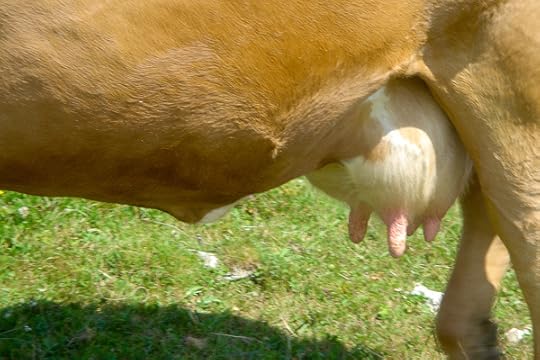
The traditional panic-mongering SF option is that the leviathan dissolves and absorbs you on contact, subsuming you as food. Or he somehow chews you up and swallows you. And this may sometimes happen. Certainly I’d like to see one of my viallains meet his end this way. Possibly the kindly elephant Darby gets eaten in this fashion as well. Maybe a few of Darby’s bones slide back out or are spit out. Grisly effect in the barn there. Maybe just one big, dramatic bone. The ER sphere burps, and out comes a bloody tibia, three feet long and a foot across.
But we’ll suppose that when my hero and heroine go into one of the leviathan’s ER maws, the creature doesn’t invoke its digestive processes. Perhaps our hero and heroine wallow through the jellied leviathan flesh and emerge from its skin in the Hibrane.
The next day I was thinking about the leviathan as soon as I woke up in the morning, and I thought about it all day, off and on, although in the meantime I had to prepare all my tax papers and bring them to the accountant, also go to the dentist. It was good to have the geometry and topology of the leviathan to think about while I was getting my teeth cleaned. It was as if, for once, I wasn’t really there. Dear Mamma Mathematica!

Anyway, the concept I slowly arrived at is that the leviathan flesh that protrudes down into the ER tunnel can have a mouth in it. On the one hand, the mouth can either lead to a toothed-vagina style channel in which you’re ground up, and then moved by peristalsis into one of the leviathan’s stomachs. On the other hand, the mouth may lead through a channel out to the leviathan’s surface, delivering you via a kind of birth canal into the Hibrane world.

I decided that the likeable oddball should be an ER bridge of the “good” latter kind, a channel to the higher world. And the dollhead ER bridge will be a “bad” one, a route to being devoured.
So below I’ve drawn, on the left, the Flatland images of the two ER balls, and on the right the diagrams of the two kinds of ER bridges involved. The tiny lazy-eight infinity signs inside the two images on the left indicate that really that central region contains the whole endless world of the Hibrane. The images on the left are oddly warped perspective images, but they indicate how a Lobraner would actually see the ER bridges.
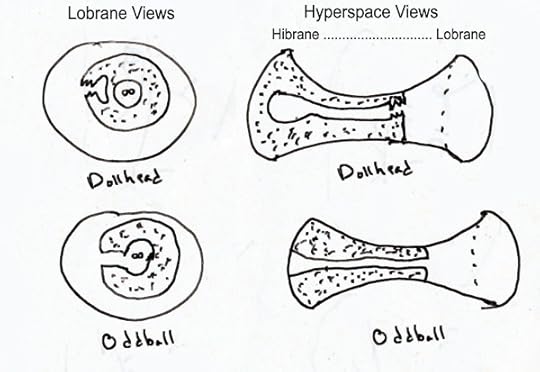
Now for more details. When my hero and heroine were handling the oddball in their apartment it didn’t feel like it had a mouth or an opening. It felt like a smooth glassy ball—and I’ve draw it that way in the figure above. We can think of the oddball or dollhead as wearing a rind. A clear outer surface over the actual leviathan flesh. Like a cornea. And when they want to get down to business, they split the cornea, and it drops off like a husk. Or with might better think of the transparent cover of the ball as like a nictitating membrane on the eye of a bird or a reptile. When it retracts, it’s covering, say, only the “back” half of the ball.
Alternately the cover gets soft and you can push through it.
The glassy oddball (with shiny rind still intact) will have a golden brownish sphere in the center, with shiny skin. And in this sphere there’s a puckered slit. After the oddball sheds or opens its rind, the mouth is uncovered. It opens up. Looking inside you’re seeing up along a tube that goes through an ER bridge. The tube may open up into Fairland, in which case you’ll “read” that as seeing a lot of tiny objects inside the mouth.
Fabulous! Eureka! Aha!
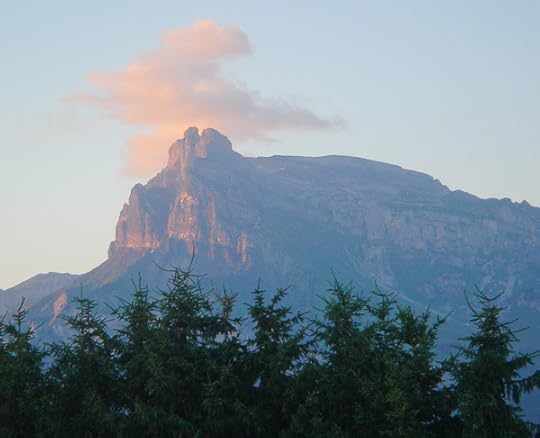
I’d been waiting for this series of insights and I wasn’t sure they were going to come, but now the Muse has favored me. Thanks in part to logic and math and weeks of butting my head against the wall and, ultimately, taking a nap on a grassy hillock one California spring day.
Okay, now to watch some Futurama on Netflix. 46 episodes done, and nearly as many to go.
Rudy Rucker's Blog
- Rudy Rucker's profile
- 584 followers





